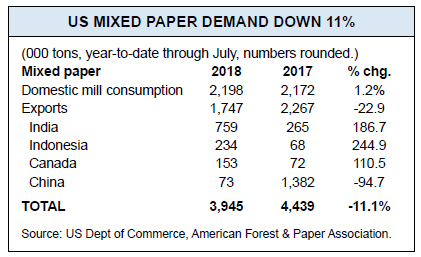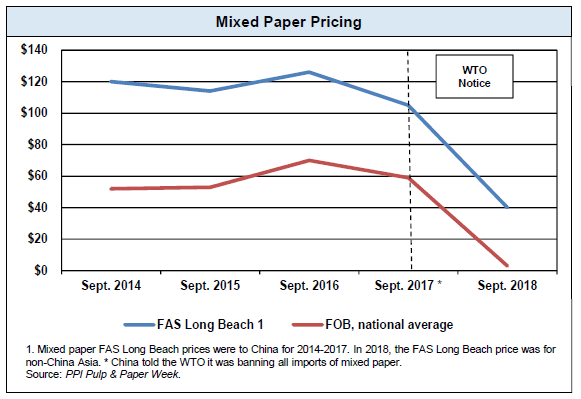Mixed paper appeared dead last July when China told the World Trade Organization it would ban global imports of the material. Now today, after landfilling it in various parts of the USA and a price crash to about $0/ton on the domestic market, three to four new containerboard capacity projects could help mixed paper make a bit of a comeback, according to PPI Pulp & Paper Week research.
Mixed paper demand could increase by about 475,000 tons from today through 2021. That’s a 12.6% increase or 4.2%/yr.
Today’s demand for US mixed paper is down 11.1% (vs last year’s total), with exports off 23% and domestic up 1.2%, so far through July, according to industry statistics.
Demand for 2018 is on track to drop to about 6.76 million tons – almost half of what it was in its glory days of 2008 and 2009 when US demand for domestic and export peaked at 11.26 million and 11.76 million tons, respectively.

The ban by China knocked out about two million tons of US mixed paper. Through July, demand was down 70,000 tons/month or 800,000 to 850,000 tons for the year. That kind of a demand decline will not nearly be met by the new projects ‒ a point that some contacts thought means that mixed paper domestic pricing may have limited upturn going forward. Those 70,000 tons/month are believed to have been landfilled.
Attracted by price. Further, US mills are attracted because of the large price differential between mixed and old corrugated containers (OCC), the two grades that are dissimilarly mixed for making both containerboard and boxboard. In the five years through 2016, OCC on average was $40/ton more than mixed paper. Today, the differential at least doubled. It was $100 in 2017 and averaged $80 the last two years. This month, domestic mixed paper was $3/ton at the FOB seller’s dock and OCC was almost $70.

A major US boxboard mill was running a mixed-like grade as part of an equipment upgrade. Some tissue mills were trying more mixed paper. A total of 75% or 2.76 million tons of mixed paper domestic consumption in 2017 was at recycled-content containerboard mills, uncoated recycled board, and coated recycled board mills, according to American Forest & Paper Association statistics. Another 19% was consumed at tissue mills for brown toweling. Looking forward, it is containerboard where mixed paper can regain some demand. Those three to four new capacity projects occur over the next 2½ years, starting with one by yearend, another in late 2019, and two more set for 2021.
“I have heard that all the mills (with capacity additions) will be using a percentage of mixed paper. If I was guessing, I would think it would be somewhere between 10% and 20%,” said a contact with a large US board system.
“It will make sense to build a machine that will give us such flexibility” to use a small amount of mixed paper, said another official at a large mill system.
“More and more mills will convert to mix due to the low cost,” a Midwest supplier claimed, “until we over-saturate the consumption and the demand raises the value. It will take a year or two. But, for single stream to continue to be viable, this needs to occur. The single-stream plants will still need to maintain a consumable quality.”
Higher quality a must. That “quality” is crucial for mixed paper’s comeback, explained a supplier, noting that US containerboard mills in the last year have run at full capacity and do not want to risk slowdowns due to dirtier raw material.
The containerboard mills “have told me that if they run mix paper, it would slow down their machines. No mill can afford to slow down because of the great demand.”
US single-stream plants, run primarily by Waste Management (WM) and Republic Services, are the largest generators of mixed and are the ones that must make a cleaner mixed paper, contacts said.
WM VP of recycling Brent Bell, who previously told P&PW that the company has upgraded its optical sorting units “to the latest technology” to clean up its quality, said this week that with some new domestic capacity coming online for mixed paper in the next year, demand will help to keep this grade afloat.
“Mixed paper can be utilized as a valid OCC substitute, and is attractive with the price differential between OCC and mixed paper,” Bell said this week. “Additional demand for mixed paper domestically will help with the movement of material that was displaced by the Chinese ban of this material.”
After China’s ban, some US containerboard mills ran tests on mixed paper to consider possibly using more of the low-priced grade. In several cases, the change was minor, from roughly 5-10% to 10-15% of a machine’s furnish. Cascades CEO Mario Plourde told analysts his company was consuming more mixed paper.
Contacts told P&PW that they expect mixed paper demand from Shanying International from what contacts claimed would be a recycled pulp line for mixed and OCC in Wickliffe, KY. The mill was formerly run by Verso. Shanying’s US affiliate said it would restart the mill by yearend.
They also expected another about 280,000 tons/yr in mixed paper demand from Pratt Industries’ new 400,000 tons/yr linerboard machine in Wapakoneta, OH, which is now being built. The Valmet PM is to start up in fourth-quarter 2019.
Green Bay Packaging is to start up a large new machine in Green Bay, WI, in the spring of 2021. The new 685,000 tons/yr Valmet PM will replace an older 240,000 tons/yr one. Construction work began two weeks ago. The PM may run on as much as 20% to 30% mixed paper, industry suppliers claimed.
It was unclear if Cascades would run mixed paper on a White Birch newsprint machine that the company plans to convert in 2021. Contacts claimed design work just started. The newsprint PM is to be converted to 400,000 tons/yr of recycled containerboard, the company has announced.
US mixed paper demand, domestically and for export, was 3.945 million tons through July, down from 4.439 million last year through July 2017. The big drop was on export because of China. US exports dropped 23% at 1.747 million tons through July, from 2.266 million last year through July.
India, Indonesia big buyers. US mixed paper to China was down by 1.3 million tons this year through July. About two-thirds of the mixed that had gone to China went to India, Indonesia, Canada, Vietnam, and Taiwan in the form of additional orders. India purchased 759,000 tons through July, almost half the total US export amount year-to-date for the grade and nearly 200% more than a year earlier. In line with Plourde’s comment, Canada’s purchases jumped by 110% to 152,514 tons through July.
US contacts believe mixed paper demand could also be helped by the recycled pulp startups in Asia and potentially the USA, as well as new containerboard projects in Southeast Asia, such as Nine Dragons’ 1.2 million tonnes/yr machine in Vietnam.
However, contacts also were concerned that countries such as India, Indonesia, and Vietnam may eventually follow China and ban mixed paper.


